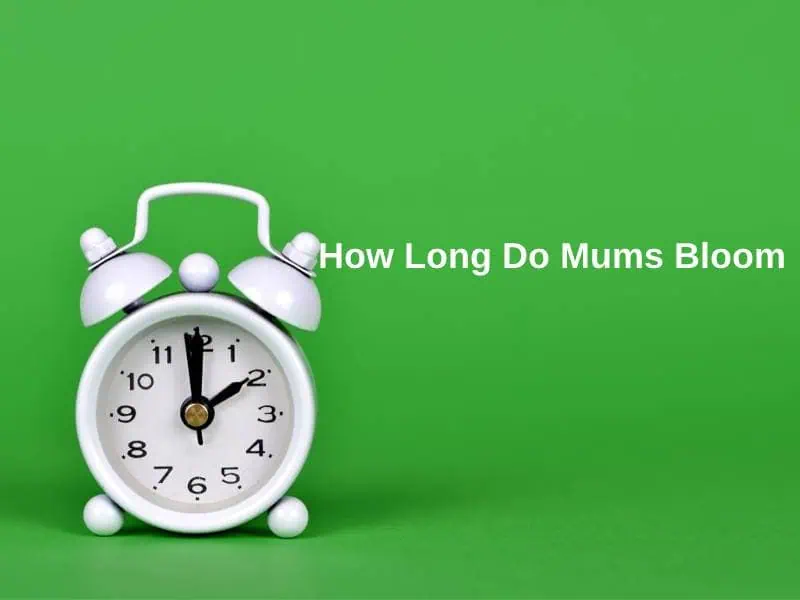Exact Answer: 4 to 6 weeks
Garden centers begin to display full masses of vivid red, yellow, and violet blooms as soon as the weather cools, signaling the arrival of fall. Mums, or chrysanthemums, are a fall garden mainstay.
Mums are an official symbol of fall plenty, and this herbaceous and hardy perennial is an easy way to add a beautiful splash of color to your fall garden scene. The robust plants are emphasized with lush, dark green leaves, and the chrysanthemum flowers range from bright whites to deep bronzes.
Although chrysanthemum blooms appear to have many petals, each solitary petal is essentially a small floret. Ray florets and disc florets are the two types of florets. The petals are made up of ray florets, while the central buttons are made up of disc florets.

How Long Do Mums Bloom?
| Types of mums | Blooms for |
| Chiffon | 5 weeks |
| Chrysanthemum | 2 to 4 weeks |
Early bloomers, early fall bloomers, and late fall bloomers are the three different types of blooming mums. Early bloomers bloom in late July, early fall bloomers bloom in September, and late fall bloomers begin their spectacular display of colors in October.
Each variety is different, however, most mums will bloom for four to eight weeks depending on sunlight and environmental condition. You can keep your mums blooming until the cold weather hits by deadheading the flowers as soon as they begin to fade.
Chrysanthemum flowering can be prolonged in a variety of methods. Your mums will produce more blooms over a longer period if you deadhead spent blooms, fertilize in the spring, and minimize overcrowding. Mums are almost exclusively a short-day plant. The long nights and short days of late summer and fall encourage flowering.
Garden mums should not be planted where the garden bed is illuminated by porch or street lights since the extra light can prevent flower buds from growing. Mums require between nine and thirteen hours of darkness to produce flowers, whether in the garden or the grower’s greenhouse.
In the spring, transplant garden chrysanthemums. Your mums will grow in a shady, well-drained spot that gets enough of the sun. Dig 2 to 4 inches of compost and well-decomposed manure into the garden bed. Plants should be spaced 18 to 24 inches apart. Carefully remove the plants from the grower pots; the stems are delicate. Backfill the planting hole after placing them in it. Water thoroughly after gently tamping down the soil.
Why Do Mums Blooms For So Long?
Mums bloom for such a long time because the flower stems naturally seal at the ends, so cutting them allows the flower to take in pure, fresh water and therefore increases its vase life. The shorter the stem, the more water the bloom will receive.
Mums are long-lasting cut flowers that can last anywhere from 7 to 14 days, depending on the type. Chrysanthemums stay fresh long after other flowers have faded, and can be spruced up by adding a few new elements to your arrangement.
Place the newly potted plant in a sunny spot and keep the soil moist but not saturated to extend the life of your mums. Overwatering your plants will lead to withering stems and soggy, decaying blossoms. To keep your mums looking fresh and healthy, deadhead as needed by removing any dead or damaged flowers, leaves, and stems.
It’s also crucial to pinch the backs of mums to induce extended blooming seasons. Start pinching them back when the plant is just 6 to 8 inches tall, and then do it again when it reaches 1 foot in height. Experts define “pinching” as simply pinching off roughly 1 inch of development from each shoot with your fingertips. The plant’s energy is forced into growth as a result of this.
Conclusion
Mums belong to the Compositae family and come in a variety of beautiful colors, shapes, and sizes. This variety of daisies was first cultivated in China about 6 centuries ago as a herb connected with the power of life.
Take care of your potted mums, especially by watering them regularly. Place them in a somewhat shaded area, as too much heat and light can shorten their blooming time. They won’t need fertilizer, but once a week, give them a boost with water-soluble plant food.